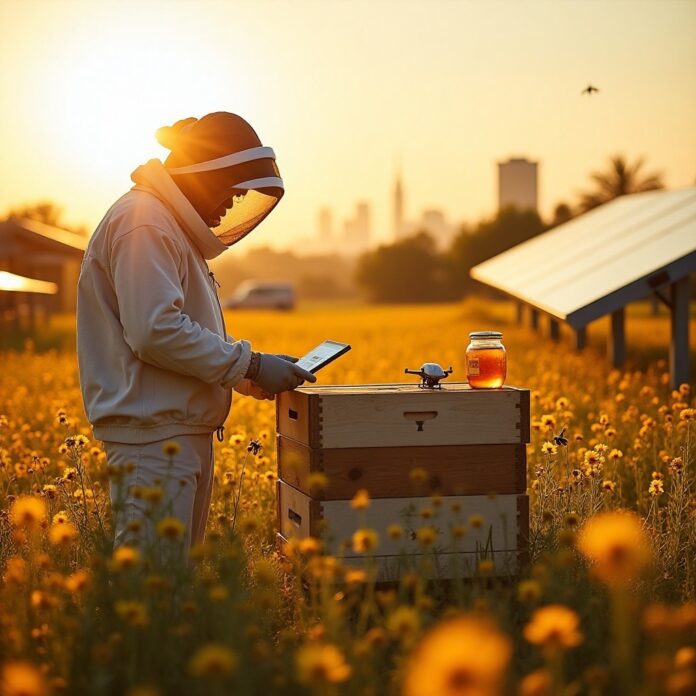Commercial beekeeping is the unsung hero of global agriculture. Beyond producing honey, your hives pollinate crops that feed billions. But this role comes with challenges: invasive pests, stringent hygiene demands, and labyrinthine export regulations. Let’s unpack how to transform these hurdles into competitive advantages—ensuring your honey not only survives but thrives in a crowded, conscientious market.
Protecting Hives from Pests and Diseases
Your hives are ecosystems under siege. Pests like Varroa destructor mites and diseases such as American foulbrood (AFB) don’t just threaten colonies—they jeopardize livelihoods. Here’s how to defend your apiary.
The Adversaries
- Varroa Mites: Parasites that weaken bees by feeding on their fat bodies and spreading lethal viruses. A 3% infestation rate demands immediate action.
- American Foulbrood (AFB): A bacterial infection that liquefies larvae. Its spores survive decades, making contaminated equipment a perpetual risk.
- Small Hive Beetles: Opportunistic scavengers that thrive in stressed colonies, spoiling honey and combs.
Proactive Monitoring
- Brood Inspections: Check for irregular cell caps, sunken patterns, or foul odors. Use the “rope test” for AFB—stretchy larval remains signal infection.
- Varroa Checks: Monthly sugar shakes or alcohol washes. IoT hive sensors offer real-time mite tracking for large operations.
- Seasonal Vigilance: Beetle populations explode in summer. Monitor hive corners for larvae and use oil traps.
Treatment Strategies
- Chemical Controls: Rotate oxalic acid vapor and formic acid strips to prevent mite resistance.
- Biological Solutions: Deploy Entomothera fungi to target beetle larvae or introduce nematodes.
- Mechanical Interventions: Screened bottom boards disrupt mite reproduction. Freeze beetle-infested frames for 24 hours.
Biosecurity Protocols
- Quarantine New Colonies: Isolate incoming hives for 30 days. Inspect brood combs before integration.
- Sterilize Relentlessly: Gamma irradiation kills AFB spores on used equipment. Scorch hive tools with propane torches daily.
- Forage Diversity: Plant clover, sunflowers, and wildflowers to boost bee immunity naturally.
Bottling Hygiene and Quality Assurance
Harvesting honey is half the battle. The bottling line is where excellence is sealed—literally.
Sanitation Standards
- Facility Design:
- Use stainless steel equipment (resists microbes better than plastic).
- Separate extraction, filtering, and bottling zones to prevent cross-contamination.
- Install HEPA filters to keep airborne particles out.
- Sterilization Rituals:
- Soak tools in food-grade hydrogen peroxide (3%) or NSF-certified detergents.
- Apply the “white glove test”: Swipe surfaces—any residue means restarting.
Moisture Mastery
- Refractometers: Calibrate daily. Ideal moisture: 17–18.5%. Over 19% risks fermentation; under 17% accelerates crystallization.
- Dehumidifiers: Run in processing rooms during humid months.
- Honey Ripening: Let raw honey settle in sealed buckets for 48 hours. Skim off bubbles and excess moisture.
Labeling & Storage
- Essentials:
- Net weight (metric and imperial).
- Origin statement (“Product of [Country]”).
- Allergen warnings if facilities handle nuts or dairy.
- Storage Wisdom:
- Keep warehouses at 50–70°F (10–21°C).
- Use amber glass or UV-resistant PET bottles.
- Elevate pallets 6 inches to deter pests.
Sustainable Packaging Innovations
- Materials:
- Glass jars (premium appeal, fully recyclable).
- Plant-based PLA plastics (compostable, derived from cornstarch).
- Reusable tins with artist collaborations.
- Functional Upgrades:
- Drip-free silicone lids.
- Laser-engraved batch numbers for traceability.
Documentation Discipline
- Batch Logs: Track harvest dates, moisture levels, storage temps.
- Third-Party Tests:
- Pesticide screens (e.g., EU’s 400+ residue panels).
- Pollen analysis for single-origin verification.
Export Certification and Global Compliance
Certifications are your passport to premium markets. Here’s how to navigate the maze.
Regional Rulebooks
- United States (USDA):
- Organic certification bans synthetic pesticides and GMO forage within 3 miles of hives.
- Grade A honey: ≤18.6% moisture, no crystals.
- European Union:
- Glyphosate limits: 0.01 mg/kg (50x stricter than the U.S.).
- Batch codes must trace back to apiary GPS coordinates.
- Canada (CFIA):
- Bilingual labels (English/French) for Quebec.
- Irradiation documentation required.
Paperwork Checklist
- Health certificates (signed by government-accredited vets).
- Certificate of Origin (prevents anti-dumping penalties).
- Lab reports for pesticides, antibiotics, and pollen DNA.
Risk Mitigation
- Pre-Shipment Prep:
- Test every 500kg batch at ISO 17025-certified labs.
- Inspect seal integrity and storage temps (raw honey must stay below 95°F/35°C).
- Digital Records: Cloud-based logs of harvest dates, weather, and treatments.
Case Study: Sunset Valley Honey
This Texas apiary cracked Asia’s luxury market by:
- Pre-testing samples in Hong Kong labs to adjust moisture.
- Partnering with Singapore distributors for ASEAN paperwork.
- Result: 300% revenue growth in 18 months.
Sustainability as Compliance Leverage
- Carbon-neutral certifications (offset shipping via reforestation).
- Bee-friendly farming partnerships (avoid neonics for EU appeal).
The Future-Proof Apiary
Commercial beekeeping balances biology, ethics, and commerce. Your blueprint for success?
- Pest Management: Blend tech (IoT monitors) with tradition (monthly sugar shakes).
- Bottling Hygiene: Turn meticulous sterilization into brand trust.
- Export Compliance: Treat certifications as chess moves—strategize for each market.
Tomorrow’s Innovations:
- AI predicting nectar flows.
- Blockchain traceability from hive to shelf.
- Regenerative farming partnerships for soil and bee health.
Sustainability Imperative:
- Zero-waste facilities.
- Carbon-negative shipping.
- Advocacy programs funding urban beekeeping.
Be the steward who marries profit with pollinator stewardship. Your honey isn’t just a product—it’s a legacy.
Commercial beekeeping is a tightrope walk between commerce and conservation. Lean too far into profit, and you’ll burn out your hives. Obsess over idealism, and payroll goes unpaid. The sweet spot? Balance.
Think of your apiary as a living, breathing entity. Nurture it with the same care you’d give a child. Train your team to spot a queen’s faltering egg-laying before it’s a crisis. Invest in lab tests like your export licenses depend on them (because they do). And never forget: Every drop of honey is a testament to your grit.
The road ahead is thorny, but the pioneers who marry tradition with innovation? They’ll inherit the hive.


